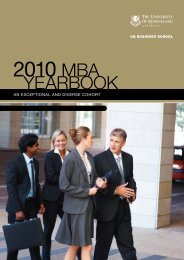Modelling the accruals process and assessing unexpected accruals*
Modelling the accruals process and assessing unexpected accruals*
Modelling the accruals process and assessing unexpected accruals*
You also want an ePaper? Increase the reach of your titles
YUMPU automatically turns print PDFs into web optimized ePapers that Google loves.
this paper). Combining <strong>the</strong> normal <strong>accruals</strong> model with <strong>the</strong> abnormal <strong>accruals</strong> model (by<br />
substituting expressions (5) <strong>and</strong> (8) into expression (9)), one yields <strong>the</strong> following <strong>accruals</strong> model:<br />
11 <br />
t1tt1 1, , 1 1,<br />
<br />
TACC a CNI CNI a a CNI<br />
t t u, t u, t1 t t1 u, t1<br />
t t t<br />
t u, t1 u, t t1 t u, t1<br />
<br />
<br />
<br />
d CNI CNI d d CNI<br />
<br />
m CNI CNI m m CNI<br />
u, t1 u, t u, t1<br />
t t t t t t<br />
As shown in section 2.2, <strong>the</strong>re are different categories of total <strong>accruals</strong>. This <strong>accruals</strong> model can<br />
be generalized to different categories of <strong>accruals</strong> with <strong>the</strong>ir respective clean-surplus flow<br />
components <strong>and</strong> parameters (see Appendix 1 <strong>and</strong> 2 for derivation). Table 3 summarizes <strong>the</strong><br />
<strong>accruals</strong> model for total <strong>accruals</strong>, total working capital <strong>accruals</strong>, non-current operating <strong>accruals</strong>,<br />
operating <strong>accruals</strong>, financing <strong>accruals</strong>, <strong>and</strong> short-term <strong>accruals</strong> used in <strong>the</strong> Jones model.<br />
[Table 3 about here]<br />
The different <strong>accruals</strong> models in table 3 look very similar to <strong>the</strong> one in (10) with several<br />
t<br />
exceptions. Firstly, <strong>the</strong>re is an operating cash flow bias in total working-capital <strong>accruals</strong> ( TWC )<br />
t<br />
<strong>and</strong> an associated investing cash flow bias in non-current operating <strong>accruals</strong> ( NCO ). This is to<br />
reflect <strong>the</strong> mis-classification of expenses as assets or revenue as liabilities; or vice versa (see<br />
McVay 2006). For instance, firms that aggressively capitalize research <strong>and</strong> development<br />
expenses will place <strong>the</strong> cash outflows as I ra<strong>the</strong>r than C; this leads to inflated C that is associated<br />
with lower I for <strong>the</strong> same period. There is no such cash flow bias in total <strong>accruals</strong> in (10) because<br />
<strong>the</strong> biases in C <strong>and</strong> I exactly offset one ano<strong>the</strong>r. Secondly, <strong>the</strong>re is no accrual component of<br />
t<br />
<strong>accruals</strong> in non-current operating <strong>accruals</strong> ( NCO ). This is because <strong>the</strong> income statement item<br />
in<br />
t<br />
NCO , depreciation expenses, is similar to deferred components of <strong>accruals</strong> where<br />
(10)<br />
21



